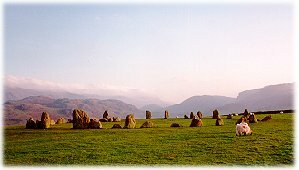Stone Circles:
An Explanation

Castle Rigg Stone Circle
These Circles vary in size, shape (they are not always round), function (as far as can be guessed), and construction.
Why were they built?
Undoubtedly some were built as burial sites (though not necessarily for this exclusive purpose), and these are a good deal smaller than sites where no evidence of burials has been found. However not all of the smaller Circles were used for burial, and over time evidence such as burial mounds found in the centre of Circles can disappear.
The majority of the Circles reveal no evidence of having been used for burial: they were probably used as meeting places for trading and ceremonial practices, rituals and festivities.
It has also been suggested that Stone Circles may have been used as primitive calendars, orientated to the paths of the Sun, Moon and larger stars. There is some evidence to support their use as such, though they would not have been built exclusively for this purpose.
In recent years speculation has grown that these Stone Circles are built on Ley Lines (mystical energy lines) and that as a consequence they have some paranormal power. There is no real evidence for this.
| EDGE Book Store | EDGE Art Gallery |
| For the castles, fortified houses and churches of England, Scotland, Wales, Ireland & the Isle of Man. | For pictures of local scenes by local artists. Watercolours, oils, photography, pastels and drawings. |